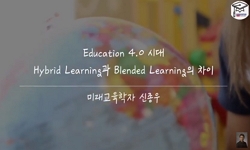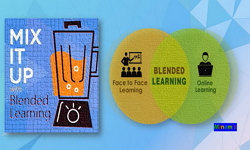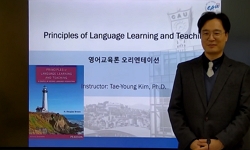This study reports the results of a survey on the needs and attitudes of English as a foreign language (EFL) learners towards blended learning (an on-line course combined with off-line lecture classes) for an on-line general English course at the univ...
http://chineseinput.net/에서 pinyin(병음)방식으로 중국어를 변환할 수 있습니다.
변환된 중국어를 복사하여 사용하시면 됩니다.
- 中文 을 입력하시려면 zhongwen을 입력하시고 space를누르시면됩니다.
- 北京 을 입력하시려면 beijing을 입력하시고 space를 누르시면 됩니다.

Traditional face to face and web‐based tutorials: a study of university students’ perception blended mode learning
한글로보기https://www.riss.kr/link?id=A101613735
- 저자
- 발행기관
- 학술지명
- 권호사항
-
발행연도
2010
-
작성언어
English
- 주제어
-
등재정보
KCI등재후보
-
자료형태
학술저널
-
수록면
157-174(18쪽)
-
KCI 피인용횟수
6
- DOI식별코드
- 제공처
- 소장기관
-
0
상세조회 -
0
다운로드
부가정보
다국어 초록 (Multilingual Abstract)
This study reports the results of a survey on the needs and attitudes of English as a foreign language (EFL) learners towards blended learning (an on-line course combined with off-line lecture classes) for an on-line general English course at the university level. Blended mode (Graham, 2006; Singh & Reed, 2001) is a growing field as an alternative to on-line or off-line only programs in language learning and teaching (Mantyla, 2001; Bersin, 2004). A survey was conducted with 33 off-line and 51 on-line university students, aiming to find useful information for developing distinctive blended learning models, one for on-line and the other for off-line environments. The findings are as follows: the two groups were similar in that i) distraction was thought of as the biggest disadvantage of on-line classes, ii) more than 42% of the students wanted to include some sort of off-line lecture combined with on-line contents, iii) about 60% of the students were willing to attend off-line lectures while taking an on-line course, and iv) the most preferred type of off-line class was such that the class meet biweekly for about two hours each time for team projects or assignment presentations and Q&A. Differences were also found: i) off-line students preferred off-line classes to on-line classes for general English courses (72% vs. 21%) whereas on-line students did not show such a preference (50% vs. 50%), ii) off-line students practically expected to attend off-line class more frequently than on-line students, and iii) on-line students showed a slight tendency to prefer Korean‐American teachers and English native speakers to Korean teachers whereas off-line students did not show such a preference tendency.
The results provide positive evidence for university students’needs as well as useful information for implementing distinctive blended mode in EFL courses for on-line and off-line university students.
다국어 초록 (Multilingual Abstract)
This study reports the results of a survey on the needs and attitudes of English as a foreign language (EFL) learners towards blended learning (an on-line course combined with off-line lecture classes) for an on-line general English course at the univ...
This study reports the results of a survey on the needs and attitudes of English as a foreign language (EFL) learners towards blended learning (an on-line course combined with off-line lecture classes) for an on-line general English course at the university level. Blended mode (Graham, 2006; Singh & Reed, 2001) is a growing field as an alternative to on-line or off-line only programs in language learning and teaching (Mantyla, 2001; Bersin, 2004). A survey was conducted with 33 off-line and 51 on-line university students, aiming to find useful information for developing distinctive blended learning models, one for on-line and the other for off-line environments. The findings are as follows: the two groups were similar in that i) distraction was thought of as the biggest disadvantage of on-line classes, ii) more than 42% of the students wanted to include some sort of off-line lecture combined with on-line contents, iii) about 60% of the students were willing to attend off-line lectures while taking an on-line course, and iv) the most preferred type of off-line class was such that the class meet biweekly for about two hours each time for team projects or assignment presentations and Q&A. Differences were also found: i) off-line students preferred off-line classes to on-line classes for general English courses (72% vs. 21%) whereas on-line students did not show such a preference (50% vs. 50%), ii) off-line students practically expected to attend off-line class more frequently than on-line students, and iii) on-line students showed a slight tendency to prefer Korean‐American teachers and English native speakers to Korean teachers whereas off-line students did not show such a preference tendency.
The results provide positive evidence for university students’needs as well as useful information for implementing distinctive blended mode in EFL courses for on-line and off-line university students.
참고문헌 (Reference)
1 Go, Y. J., "The effects of Blended e-Learning Programs on English speaking proficiency" Korea National Education University 2008
2 Cho, I. H., "The blended learning strategies and ROL" Credu 2003
3 Bersin, J., "The blended learning book" Pfeiffer 2004
4 Graham, C. R., "Blended learning systems: definition, current trends, and future directions. in: Handbook of blended learning" Pfeiffer 2006
5 Osguthorpe, R, T., "Blended learning environments" 4 (4): 227-233, 2003
6 Lee, H., "Blended e‐learning strategies for effective teaching in traditional universities" 2005
7 Mantyla, K., "Blended Learning: The power is in the mix. in: American Society for Training & Development" ASTD 2001
8 Singh, H., "A white paper: Achieving success with blended learning. in: American Society for Training & Development (ASTD) Sate of the Industry Report" 2001
1 Go, Y. J., "The effects of Blended e-Learning Programs on English speaking proficiency" Korea National Education University 2008
2 Cho, I. H., "The blended learning strategies and ROL" Credu 2003
3 Bersin, J., "The blended learning book" Pfeiffer 2004
4 Graham, C. R., "Blended learning systems: definition, current trends, and future directions. in: Handbook of blended learning" Pfeiffer 2006
5 Osguthorpe, R, T., "Blended learning environments" 4 (4): 227-233, 2003
6 Lee, H., "Blended e‐learning strategies for effective teaching in traditional universities" 2005
7 Mantyla, K., "Blended Learning: The power is in the mix. in: American Society for Training & Development" ASTD 2001
8 Singh, H., "A white paper: Achieving success with blended learning. in: American Society for Training & Development (ASTD) Sate of the Industry Report" 2001
동일학술지(권/호) 다른 논문
-
The Use of Collective Numeral Phrases in Bosinan/Croatian/Serbian: Morphosemantic Approach
- 중앙대학교 외국학연구소
- 김형섭
- 2010
- KCI등재후보
-
慶尙道 昌原方言의 漢字音聲調體系 -日本의 漢․吳音聲調와의 比較考察-
- 중앙대학교 외국학연구소
- 이성근
- 2010
- KCI등재후보
-
고골의 『이반 꾸빨라 전야』에 나타난 민속적 모티프와 기독교적 모티프
- 중앙대학교 외국학연구소
- 이영범
- 2010
- KCI등재후보
-
- 중앙대학교 외국학연구소
- 박혜자
- 2010
- KCI등재후보
분석정보
인용정보 인용지수 설명보기
학술지 이력
| 연월일 | 이력구분 | 이력상세 | 등재구분 |
|---|---|---|---|
| 2022 | 평가예정 | 재인증평가 신청대상 (재인증) | |
| 2019-01-01 | 평가 | 등재학술지 유지 (계속평가) |  |
| 2016-01-01 | 평가 | 등재학술지 유지 (계속평가) |  |
| 2013-04-22 | 학회명변경 | 영문명 : FOREIGN STUDIES CENTER -> FOREIGN STUDIES INSTITUTE |  |
| 2012-01-01 | 평가 | 등재학술지 선정 (등재후보2차) |  |
| 2011-01-01 | 평가 | 등재후보 1차 PASS (등재후보1차) |  |
| 2009-01-01 | 평가 | 등재후보학술지 선정 (신규평가) |  |
| 2007-09-03 | 학회명변경 | 한글명 : 외국어문학연구소 -> 외국학연구소 |
학술지 인용정보
| 기준연도 | WOS-KCI 통합IF(2년) | KCIF(2년) | KCIF(3년) |
|---|---|---|---|
| 2016 | 0.28 | 0.28 | 0.25 |
| KCIF(4년) | KCIF(5년) | 중심성지수(3년) | 즉시성지수 |
| 0.22 | 0.2 | 0.437 | 0.12 |




 KCI
KCI







